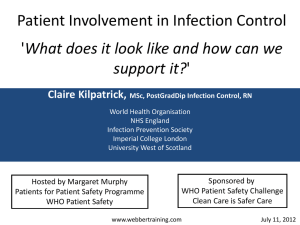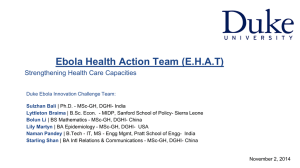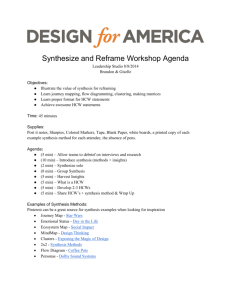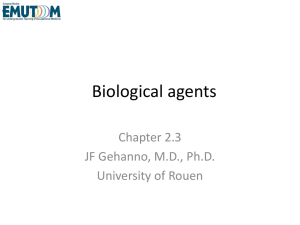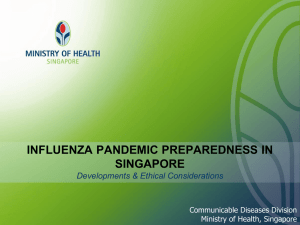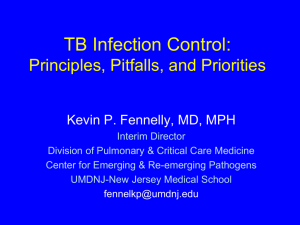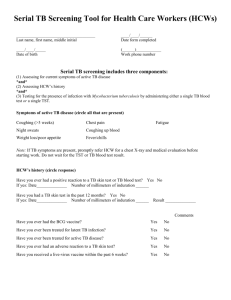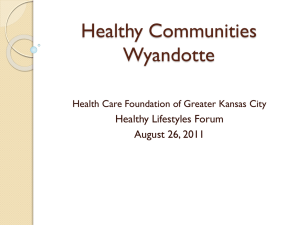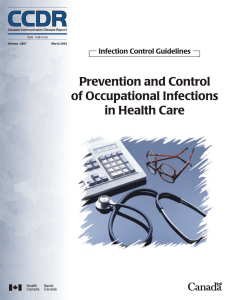Reconsidering Hand Hygiene Monitoring
advertisement
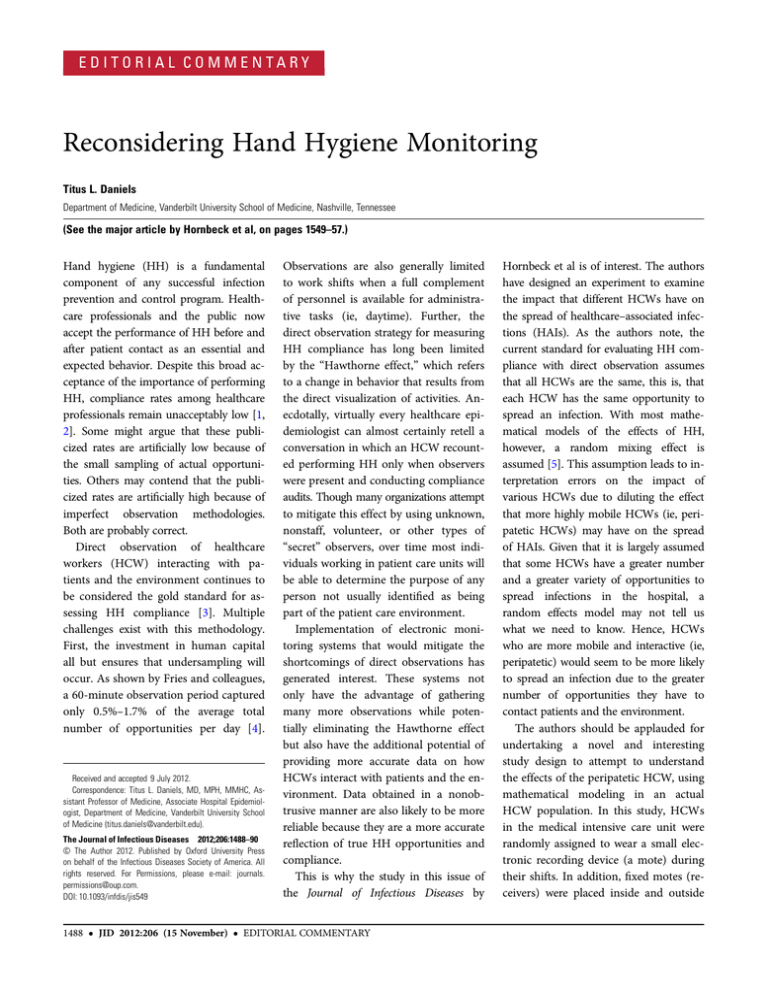
EDITORIAL COMMENTARY Reconsidering Hand Hygiene Monitoring Titus L. Daniels Department of Medicine, Vanderbilt University School of Medicine, Nashville, Tennessee (See the major article by Hornbeck et al, on pages 1549–57.) Hand hygiene (HH) is a fundamental component of any successful infection prevention and control program. Healthcare professionals and the public now accept the performance of HH before and after patient contact as an essential and expected behavior. Despite this broad acceptance of the importance of performing HH, compliance rates among healthcare professionals remain unacceptably low [1, 2]. Some might argue that these publicized rates are artificially low because of the small sampling of actual opportunities. Others may contend that the publicized rates are artificially high because of imperfect observation methodologies. Both are probably correct. Direct observation of healthcare workers (HCW) interacting with patients and the environment continues to be considered the gold standard for assessing HH compliance [3]. Multiple challenges exist with this methodology. First, the investment in human capital all but ensures that undersampling will occur. As shown by Fries and colleagues, a 60-minute observation period captured only 0.5%–1.7% of the average total number of opportunities per day [4]. Received and accepted 9 July 2012. Correspondence: Titus L. Daniels, MD, MPH, MMHC, Assistant Professor of Medicine, Associate Hospital Epidemiologist, Department of Medicine, Vanderbilt University School of Medicine (titus.daniels@vanderbilt.edu). The Journal of Infectious Diseases 2012;206:1488–90 © The Author 2012. Published by Oxford University Press on behalf of the Infectious Diseases Society of America. All rights reserved. For Permissions, please e-mail: journals. permissions@oup.com. DOI: 10.1093/infdis/jis549 1488 • JID 2012:206 (15 November) • Observations are also generally limited to work shifts when a full complement of personnel is available for administrative tasks (ie, daytime). Further, the direct observation strategy for measuring HH compliance has long been limited by the “Hawthorne effect,” which refers to a change in behavior that results from the direct visualization of activities. Anecdotally, virtually every healthcare epidemiologist can almost certainly retell a conversation in which an HCW recounted performing HH only when observers were present and conducting compliance audits. Though many organizations attempt to mitigate this effect by using unknown, nonstaff, volunteer, or other types of “secret” observers, over time most individuals working in patient care units will be able to determine the purpose of any person not usually identified as being part of the patient care environment. Implementation of electronic monitoring systems that would mitigate the shortcomings of direct observations has generated interest. These systems not only have the advantage of gathering many more observations while potentially eliminating the Hawthorne effect but also have the additional potential of providing more accurate data on how HCWs interact with patients and the environment. Data obtained in a nonobtrusive manner are also likely to be more reliable because they are a more accurate reflection of true HH opportunities and compliance. This is why the study in this issue of the Journal of Infectious Diseases by EDITORIAL COMMENTARY Hornbeck et al is of interest. The authors have designed an experiment to examine the impact that different HCWs have on the spread of healthcare–associated infections (HAIs). As the authors note, the current standard for evaluating HH compliance with direct observation assumes that all HCWs are the same, this is, that each HCW has the same opportunity to spread an infection. With most mathematical models of the effects of HH, however, a random mixing effect is assumed [5]. This assumption leads to interpretation errors on the impact of various HCWs due to diluting the effect that more highly mobile HCWs (ie, peripatetic HCWs) may have on the spread of HAIs. Given that it is largely assumed that some HCWs have a greater number and a greater variety of opportunities to spread infections in the hospital, a random effects model may not tell us what we need to know. Hence, HCWs who are more mobile and interactive (ie, peripatetic) would seem to be more likely to spread an infection due to the greater number of opportunities they have to contact patients and the environment. The authors should be applauded for undertaking a novel and interesting study design to attempt to understand the effects of the peripatetic HCW, using mathematical modeling in an actual HCW population. In this study, HCWs in the medical intensive care unit were randomly assigned to wear a small electronic recording device (a mote) during their shifts. In addition, fixed motes (receivers) were placed inside and outside all patient rooms. This network of receivers could then record the movements of the HCWs wearing the motes by noting the signal strength and duration of proximity to the receivers. Using bed occupancy data, the authors were then able to use the receiver and mote data to identify HH opportunities for the different categories of HCWs. The authors established their model by simulating the spread of organisms that are spread by direct contact [6]. First, the authors used varying parameters of transmissibility and effectiveness of HH with either soap and water or alcohol rub. Considering predefined HH compliance rates of low (25%), medium (50%), and high (75%), the authors then simulated the spread of pathogens based on data obtained from the actual patterns of HCWs wearing the motes. By replaying HCW–HCW and HCW–patient interactions using a proprietary agentbased discrete-event simulator, the authors were able to simulate the impact that the peripatetic HCW had on infection transmission. Replaying simulations among the various scenarios of HCW HH compliance yielded some very interesting results. The authors demonstrate that HCWs who are most connected (ie, peripatetic) are indeed more likely to spread infection, given the assumptions of HH compliance of 50% and alcohol hand rub effectiveness of 83% with varying levels of environmental contamination. Figures 2 and 4 of their article provide the most notable findings. Specifically, when the 2 most connected HCWs are not compliant with HH, the infection counts are higher, even with a low probability of transmission. Lately, there has been renewed interest in determining the role of environmental contamination in the transmission of infections. Figure 4 demonstrates that when the environment is contaminated, the infection count is appreciably greater, even among those HCWs who are most compliant with HH. This effect is compounded with the peripatetic HCW, but the difference between the most and least connected HCWs is less substantial when environmental contamination is present. Though the current study demonstrates some interesting results, it is not without limitations. Principally, this is a mathematical modeling study with fixed assumptions for HH compliance, HH product effectiveness, and the contribution of environmental contamination on transmission of infection. That HCW– patient interactions are based on actual data obtained on HCW movements enhances this modeling study. The opportunity for HH was defined as an in-room dwell time of 30 seconds. Given that patients in intensive care units (ICUs) are not usually mobile, this methodology is generally applicable to critically ill patients. However, the ability to generalize these findings to non-ICU patients is limited, given the greater mobility and out-of-room time that is likely with this patient population. Further, simply being present in the room of a patient is not necessarily an opportunity for HH because HCWs may simply be standing and talking with patients or visitors. Additionally, the authors use a proprietary system for electronic monitoring and analysis. Most institutions would have difficulty operationalizing a similar system in order to determine more accurate HH compliance. Such costs are undoubtedly prohibitive, especially given current economic challenges facing healthcare institutions. The data presented here support the proposition that not all HCWs are the same with regard to their roles in the transmission of infection. But how should such data be used? There are clear unintended consequences of electronic surveillance data that can be traced to an individual HCW. Ellingson et al [7] reviewed HCW’s perceptions of HH monitoring technology through focus groups at the same institution as that of Hornbeck et al’s study, revealing that only 45% of HCWs were even aware of the monitoring technology. HCWs also expressed only moderate comfort with the use of such technology. However, electronic monitoring technology not only allows for a more accurate assessment of HH compliance but also allows for direct and individual performance accountability, provided that the data are accurate. It is interesting to note that Ellingson et al were able to solicit comments regarding “Big Brother” and HCW’s feelings that HH monitoring technology made them feel untrustworthy. As a profession, however, we must accept the responsibility of regulating ourselves. If the performance of HH in any organization is at acceptable levels, and if individual healthcare professionals adhere to a standard of conduct expected not only by patients but also by our profession, then there should be no objection to monitoring compliance through the use of technologies described by Hornbeck et al. Similar to how we have come to expect and demand transparency among our elected officials, I submit that the trust that patients place in their healthcare team to “first do no harm” demands both transparency and accountability. Implementation of reliable systems that inform with greater accuracy about who is and who is not adhering to fundamental aspects of safe patient care is a hallmark of being part of a profession. The time has come to move forward and hold ourselves accountable. Though these are difficult decisions we make as a profession, we may find support in the Oath of Maimonides: “Grant me the strength, time and opportunity always to correct what I have acquired, always to extend its domain; for knowledge is immense and the spirit of man can extend indefinitely to enrich itself daily with new requirements.” Therefore, we must use what we learn from science and data to “watch over the life and health of thy creatures.” Note Potential conflicts of interest. Author certifies no potential conflicts of interest. EDITORIAL COMMENTARY • JID 2012:206 (15 November) • 1489 The author has submitted the ICMJE Form for Disclosure of Potential Conflicts of Interest. Conflicts that the editors consider relevant to the content of the manuscript have been disclosed. References 1. Boyce JM, Pittet D. Guideline for Hand Hygiene in Health-Care Settings. Recommendations of the healthcare infection control practices advisory committee and the HIPAC/ SHEA/APIC/IDSA hand hygiene task force. Am J Infect Control 2002; 30:S1–46. 1490 • JID 2012:206 (15 November) • 2. Pittet D, Allegranzi B, Boyce J. The world health organization guidelines on hand hygiene in health care and their consensus recommendations. Infect Control Hosp Epidemiol 2009; 30:611–22. 3. World Health Organization (WHO): WHO Guidelines for Hand Hygiene in Health Care (Advanced Draft). Geneva: WHO, 2006. 4. Fries J, Segre AM, Thomas G, Herman T, Ellingson K, Polgreen PM. Monitoring hand hygiene via human observers: how should we be sampling? Infect Control Hosp Epidemiol 2012; 33:689–95. EDITORIAL COMMENTARY 5. Read JM, Keeling MJ. Disease evolution on networks: the role of contact structure. Proc Biol Sci 2003; 270:699–708. 6. Temime L, Opatowski L, Pannet Y, BrunBuisson C, Boelle PY, Guillemot D. Peripatetic health-care workers as potential superspreaders. Proc Natl Acad Sci U S A 2009; 106: 18420–5. 7. Ellingson K, Polgreen PM, Schneider A, et al. Healthcare personnel perceptions of hand hygiene monitoring technology. Infect Control Hosp Epidemiol 2011; 32: 1091–6.

